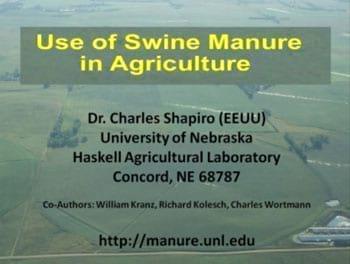Methods to Reduce H2S Levels in Swine Facilities
Published: September 17, 2008
Source : Prairie Swine Centre Publication
Introduction
A previous PSCI study found swine barn workers can be at risk of H2S exposure while performing manure management tasks, such as pulling pit-drain plugs to clear manure out of swine production rooms. Occupational regulations stipulate that worker exposure to H2S should not exceed an 8-h timeweighted average (TWA) of 10 ppm, or a 15-min short-term exposure limit (STEL) of 15 ppm. Out of 119 plug-pulling events monitored in different sections of various barns, 29% generated peak H2S values higher than 100 ppm, and 48% generated 15-min TWA values higher than the 15 ppm STEL value at the worker level. Because extended manure storage times can contribute to anaerobic degradation processes that give rise to H2S gas, an in-barn manure handling system that allows more frequent and complete removal of manure from production rooms has the potential to reduce H2S production. Hence, the goal of this study was to evaluate the effectiveness of a manure scraper system to reduce the risk of exposure of swine barn workers and animals to H2S gas.

Experimental Procedures
Two identical grower-finisher rooms at PSCI were used for this experiment. A total of 70 pigs per room were used at a starting weight of about 21.5 kg and remained in the rooms for 12 weeks for each trial. A manure scraper system (Fig. 1) was installed in one room (Scraper). The other room (Control) was operated normally, i.e., manure was allowed to accumulate in the pits, and was drained on a predetermined schedule by pulling the pit-drain plugs.
The room air quality and H2S concentrations in both rooms were monitored over four production cycles (trials). Two H2S monitors (Model Pac III, with XS EC 1000 ppm H2S sensor, Draeger, Lübeck, Germany) were installed in each room: one over the middle of the pit (middle pen) and another directly above the plug, both at about 1 m off the floor. Ammonia concentrations were measured at the inlet and outlet of both rooms using an ammonia analyzer (Model Chillgard RT, MSA Canada, Edmonton, AB).

Figure 2. Weekly least square mean (LSM) ammonia concentrations (C) and emission rates (E) for the Scraper and Control rooms. Error bars represent SE, and n is the number of values used in the LSM.
Results and Discussion
Based on the average readings from both measuring locations, the Scraper room had significantly lower peak
H2S concentration levels than the Control room (p<0.05), equivalent to an average reduction of 90% (Table 1). Similarly, the scraper system significantly lowered the TWA H2S concentrations (p<0.05) by an average of about 96%.
More frequent manure removal using the scraper system did not affect the ammonia concentration measured at the outlet of the rooms (p>0.10) (Fig. 2). On average, 35.6% more ammonia was emitted from the Scraper room compared to the Control room, indicating that the manure removal system tended to increase room emission (p<0.10). Weekly average ammonia emissions also increased significantly (p<0.001) as each trial progressed, mainly due to increased manure production and ventilation rates required to account for increased heat and moisture production.
Conclusions
Overall, the results demonstrated the effectiveness of the scraper system in reducing H2S exposure of swine barn workers, with marginal impact on ammonia production. Based on the installation and operating costs associated with this study, the estimated cost to construct and operate a similar scraper system in a new or
existing facility is about $2 to $3 per pig sold, respectively. However, this cost does not take into account the benefits of improved worker safety.
Acknowledgements
Strategic funding provided by Sask Pork, Alberta Pork, Manitoba Pork Council, and Saskatchewan Agriculture and Food Development Fund. Technical support was provided by Shala Christianson, Robert Fengler and Karen Stewart.
Authors: B.Z. Predicala1, E.L. Cortus1, S.P. Lemay2, C. Laguë3
1 Prairie Swine Centre,
2 Institut de Recherche et de Développement en Agroenvironnement, and
3 University of Saskatchewan
Source
Prairie Swine Centre PublicationRelated topics
Recommend
Comment
Share

Would you like to discuss another topic? Create a new post to engage with experts in the community.





